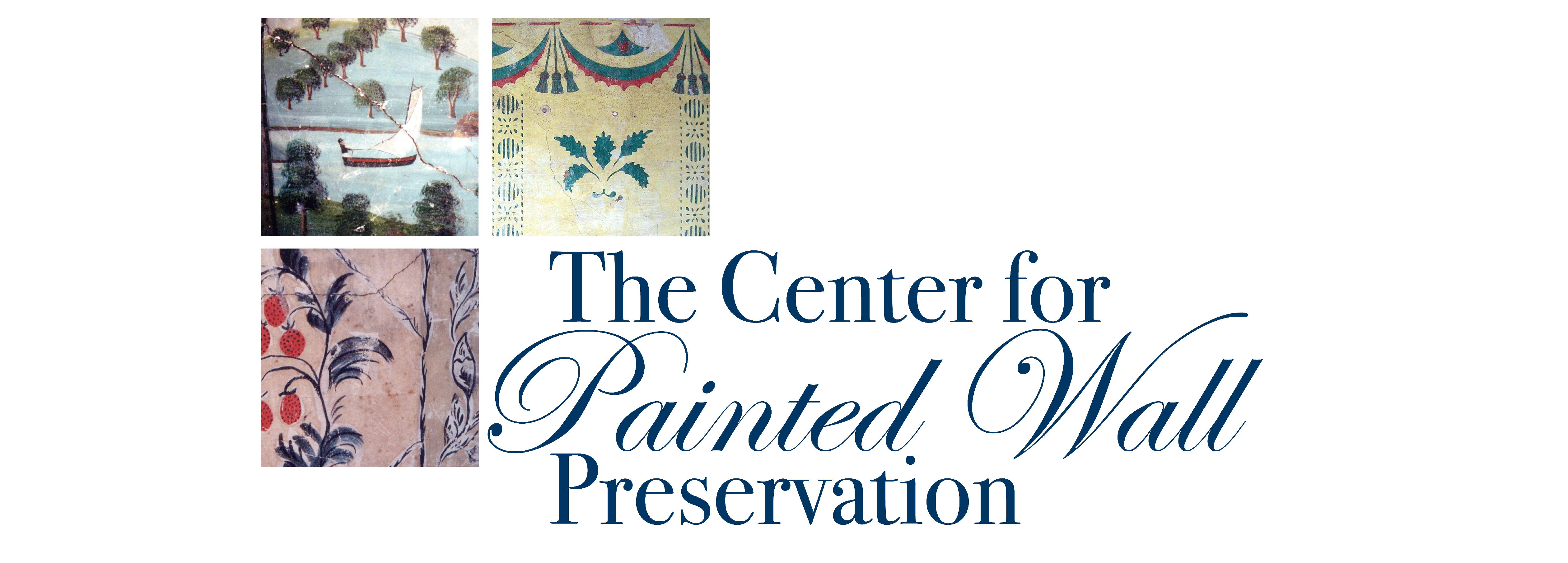
Wall Attribution
Traditionally the work of many different artists has been erroneously attributed to two of the major wall decorators of the early 1800’s: Rufus Porter and Moses Eaton.
The recent study of motifs by Lefko and Radclifffe, in their publication Folk Art Murals of the Rufus Porter School: New England Landscapes 1825-1845 (Schiffer), clarifies the fact that many muraled walls previously thought to be done by Porter were actually painted by his nephew, Jonathan D. Poor. In fact, some of the previously Porter attributions actually had J.D. Poor’s signature on them.
In the case of wall stenciling, it is a known fact that Moses Eaton Sr. was the most documented stenciler of New England. He moved to Hancock, New Hampshire in 1792 from Needham, Massachusetts at the age of 40 and he could have begun work as early as 1800. In the Hancock, Dublin, Peterborough area there are many examples of walls decorated with the same patterns found years later in the original kit of wall stencils retrieved from his attic.
Moses Eaton, Jr., born in 1796, is also known to have worked with his father before striking out on his own. It is known that many men shared this profession and that exchanging patterns was commonplace. Moses Eaton's patterns themselves, although influenced in placement of design by wallpapers, could not, in their simplicity, hope to reproduce the same hand-painted or machine produced overlay of colors which inspired them. That is why New England wall stenciling became an art form in its own right.
Wall stenciling has at least three different types of layouts - the open (repeated designs fill in space between architectural elements), vertical panel,( wall is divided into panels by narrow vertical borders which are filled in with alternating filler designs) and border only ( only the areas around the architectural elements have stenciled borders with wall center left open).
There are a variety of different recognized wall stencilers, some have even signed their walls with a stenciled signature.
Symbolism abounds in the various motifs. The swag and pendant, known as the liberty bell, was a patriotic emblem of post-Revolutionary America. Of those derived from nature, the flower baskets represented friendship; the oak leaf, strength and loyalty; the willow, everlasting life; and the pineapple, hospitality. Hearts then, as today, stood for love and happiness, and were part of the "redding up" of a homestead for a new bride. (Information on the Eaton family courtesy of P. Forcier, MBHistoricDécor.)
Wall Value
There is little if any value to walls that have been "restored" by non-professionals. Once a wall has been overpainted it is almost always non-reversible without damaging the original layer of paint. Walls in their original location that have not been painted, wallpapered or covered have the greatest intrinsic value. Walls removed from their original location without a buyer often go into storage for years.
Historic value includes what value they add to the house in situ. This is where the eye of the beholder is critical. A buyer who appreciates historic art will pay more for the house with the walls intact if given a choice of a house with murals or one without. A buyer with no interest will not pay any more for the house and will probably destroy or cover up the painted walls. To the community, historic murals are an invaluable connection to the past, often documenting lost architecture and other regional landmarks and customs. Their importance is an intangible value that is difficult to determine in monetary terms. The fact that they are documented will help in the historical records, as there is no accountability for their existence when these homes change hands. Realtors will tell you they add NO financial value to a home when for sale, but this of course depends on the pool of buyers and their historic value is literally priceless to the community and future generations.
Walls are expensive and difficult to extricate from buildings and are usually further compromised in the removal process, unless an experienced extractor is used. It would NOT be recommended to have walls removed unless there is a contract in place for their purchase. They are cumbersome to handle and usually end up in storage until a buyer is found. Climatic conditions in storage need to be stable so the paint isn’t compromised. It should be noted that when walls are consigned for public sale, the homeowner receives only a small percentage of the final selling price. There is the cost of removal, stabilization, storage, auction percentage (usually one third) and/or dealer’s commission on sale.
The other question often arising for the owner of murals is insurance on the painted walls in the house. Private homes are truly at the mercy of the chain of owners through whose hands they pass. For insurance purposes, careful documentation is essential. Accurate color photographs both of detail and of layout, (kept stored in a separate location), are critical. The walls can never be replaced, so they can’t be insured for replacement value. Insurance similar to a fine arts policy on objects (only in this case, a structure) may be obtainable if you can find an insurance company willing to accept an appraisal.

